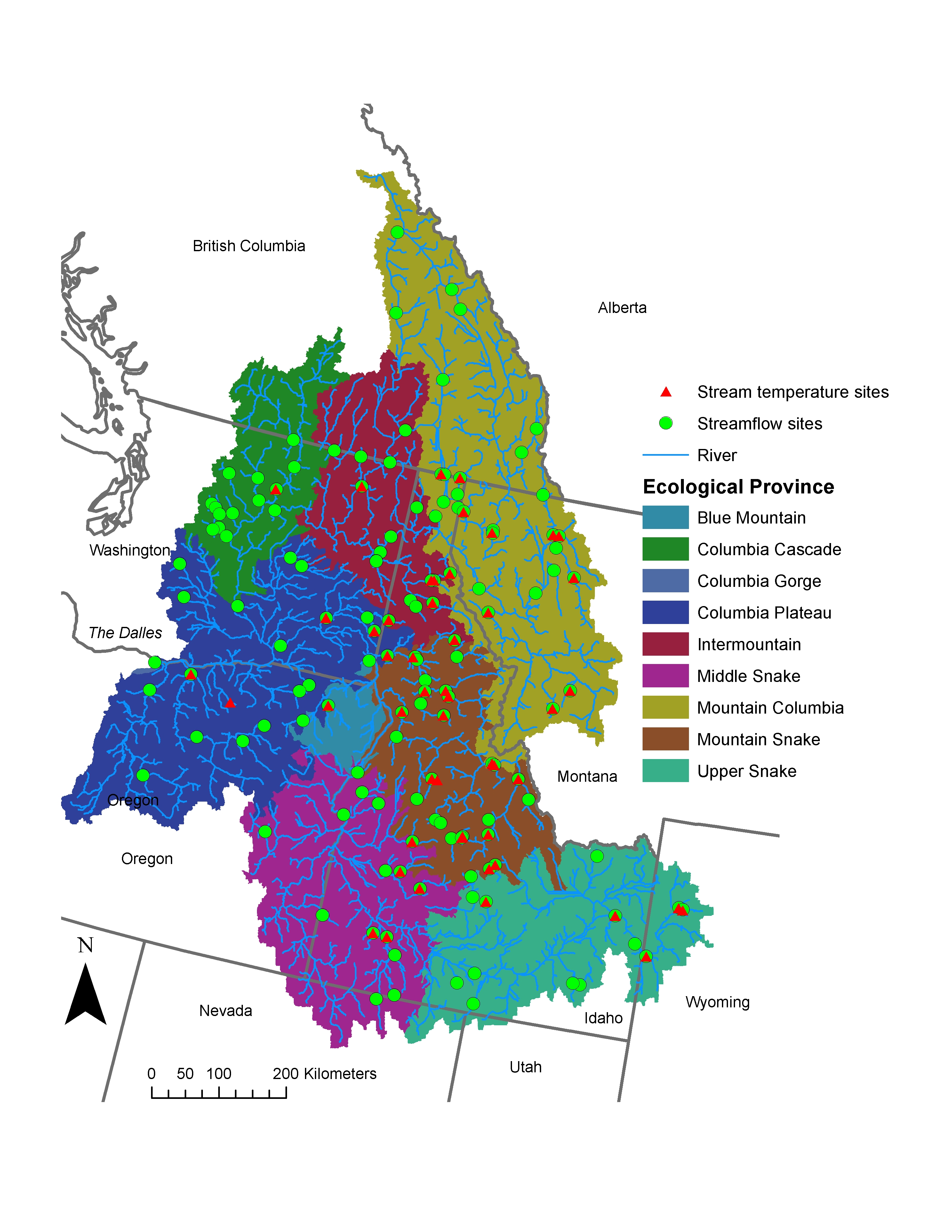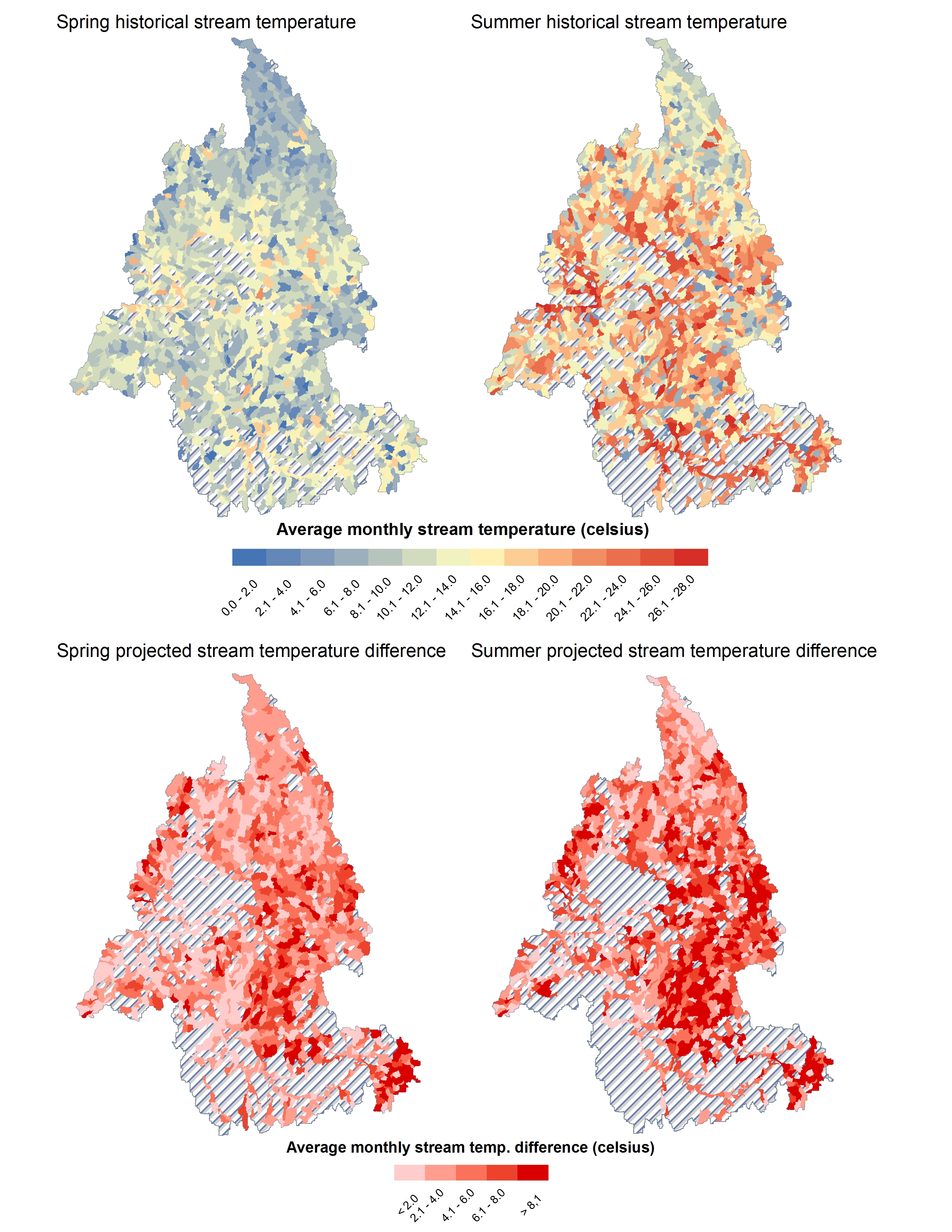
Cold-water fish habitat affected by warmer climate in the Columbia River Basin
Researchers and water managers have wondered how much heat the fish will have to take.
The Columbia River Basin is a network of streams that spans the states of Washington, Oregon, Montana, Idaho and British Columbia (see first Figure below) and that provides water for public water supplies, irrigation, and for important salmon runs and other species adapted to its cold and forceful waters.
 Water temperature in a stream is an important physical factor that regulates which fish and other aquatic species can not only survive, but thrive. With warmer temperatures attributed to climate change, that have been observed in the western U.S. mountains there is concern that not only air temperatures, but also stream temperatures will continue to warm up - beyond levels that cold-water native species can tolerate. Stream temperatures are to a large degree determined by air temperatures and by the temperatures of the various waters that mix in a stream, such as water coming from precipitation, water entering a stream from other tributaries or from upslope portions of a watershed, from groundwater, from flow through the soil layer, and from snowmelt. When temperature and precipitation patterns change, the interactions between physical processes shift in ways that affect stream flow and stream temperature regimes. For example, with warmer temperatures, less precipitation is deposited as snow,and snow melts earlier in the year, but warmer air temperatures affect a stream at the same time as the colder water from snowmelt enters it.
Water temperature in a stream is an important physical factor that regulates which fish and other aquatic species can not only survive, but thrive. With warmer temperatures attributed to climate change, that have been observed in the western U.S. mountains there is concern that not only air temperatures, but also stream temperatures will continue to warm up - beyond levels that cold-water native species can tolerate. Stream temperatures are to a large degree determined by air temperatures and by the temperatures of the various waters that mix in a stream, such as water coming from precipitation, water entering a stream from other tributaries or from upslope portions of a watershed, from groundwater, from flow through the soil layer, and from snowmelt. When temperature and precipitation patterns change, the interactions between physical processes shift in ways that affect stream flow and stream temperature regimes. For example, with warmer temperatures, less precipitation is deposited as snow,and snow melts earlier in the year, but warmer air temperatures affect a stream at the same time as the colder water from snowmelt enters it.
The century is still young, but several years have already broken records, and 2014 was recently declared the warmest year on record on the global scale.
And air temperatures are expected to rise further in the coming decades, with concurrent changes in precipitation. Thus accurate assessments of the thermal habitats in freshwater systems are critical for predicting aquatic species' responses to changes in climate and for guiding adaptation strategies. For this project, ESS faculty member Iris Stewart and CE faculty member Ed Maurer and their colleagues used a hydrologic model, coupled with a stream temperature model they developed, and output from global climate models (called general circulation model or ‘GCMs’) that are adapted to the local climate patterns (or ‘downscaled’) to explore the spatially and temporally varying changes in stream temperature for the late 21st century at the scale of both small watersheds (sub-basins) and ecological provinces for the Columbia River Basin.
 They found that, on average, stream temperatures are projected to increase 3.5 °C for the spring, 5.2 °C for the summer, 2.7 °C for the fall, and 1.6 °C for the winter, which are significant changes for such a large system as is the Columbia River Basin. At the ecological province scale, the largest increase in annual stream temperature was within the Mountain Snake ecological province, which is home to migratory cold water fish species. The hydrologic models captured the important, and often ignored, influence of hydrological processes on changes in stream temperature on the local scale. Their work shows, that decreases in future snow cover will result in increased thermal sensitivity within regions that were previously buffered by the cooling effect of flow originating as snowmelt. The largest increases in stream in all ecological provinces are forecast for the spring and summer, already a critical time for water supplies and aquatic habitats.
They found that, on average, stream temperatures are projected to increase 3.5 °C for the spring, 5.2 °C for the summer, 2.7 °C for the fall, and 1.6 °C for the winter, which are significant changes for such a large system as is the Columbia River Basin. At the ecological province scale, the largest increase in annual stream temperature was within the Mountain Snake ecological province, which is home to migratory cold water fish species. The hydrologic models captured the important, and often ignored, influence of hydrological processes on changes in stream temperature on the local scale. Their work shows, that decreases in future snow cover will result in increased thermal sensitivity within regions that were previously buffered by the cooling effect of flow originating as snowmelt. The largest increases in stream in all ecological provinces are forecast for the spring and summer, already a critical time for water supplies and aquatic habitats.
A pdf of the paper, which appeared in the open access journal Hydrological Earth System Science (HESS) can be downloaded from here: PDF
Citation: Ficklin, D. L., Barnhart, B. L., Knouft, J. H., Stewart, I. T., Maurer, E. P., Letsinger, S. L., and Whittaker, G. W.: Climate change and stream temperature projections in the Columbia River basin: habitat implications of spatial variation in hydrologic drivers, Hydrol. Earth Syst. Sci., 18, 4897-4912, doi:10.5194/hess-18-4897-2014, 2014.
Photo of Columbia River by Iris Stewart-Frey